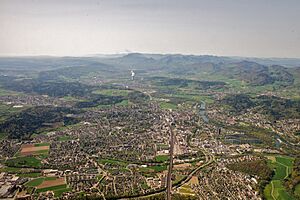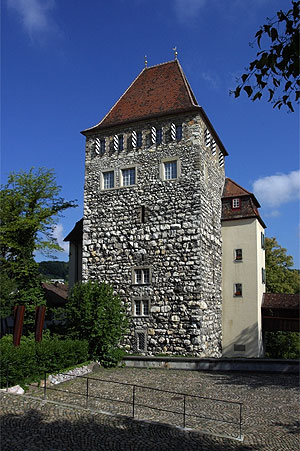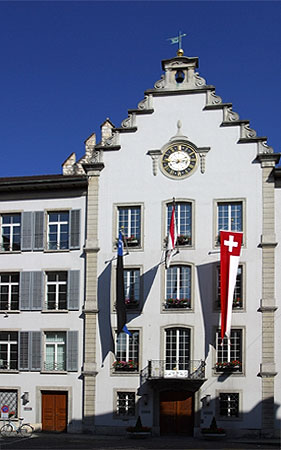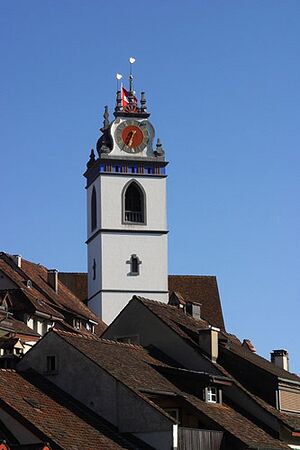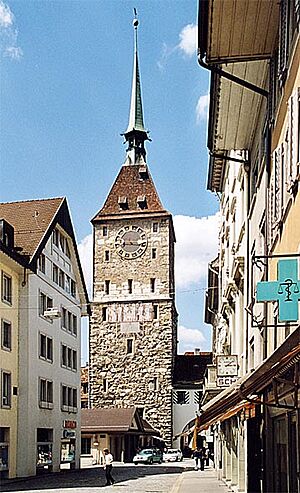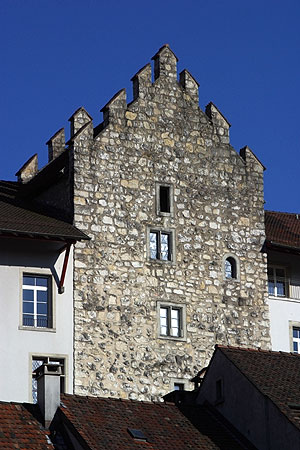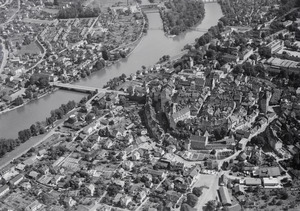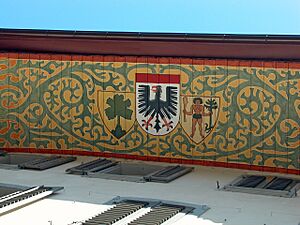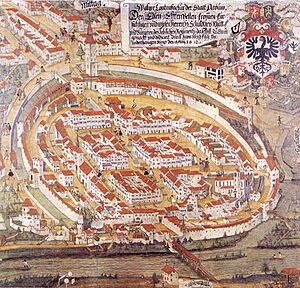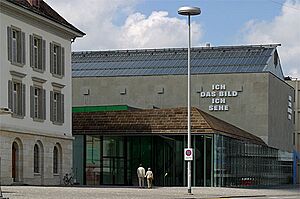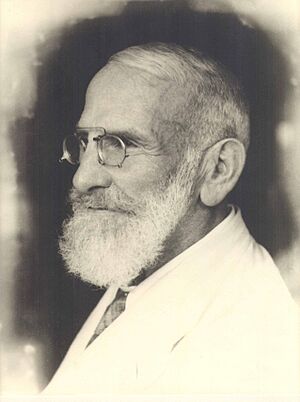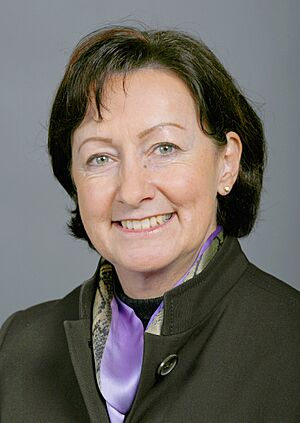Aarau facts for kids
Quick facts for kids
Aarau
|
|||
|---|---|---|---|
|
Municipality
|
|||
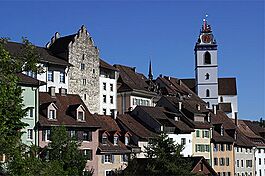
Aarau old town
|
|||
|
|||
| Country | Switzerland | ||
| Canton | Aargau | ||
| District | Aarau | ||
| Area
Lua error in Module:Wd at line 1575: attempt to index field 'wikibase' (a nil value).
|
|||
| • Total | Lua error in Module:Wd at line 1,575: attempt to index field 'wikibase' (a nil value). km2 (Formatting error: invalid input when rounding sq mi) | ||
| Elevation | 381 m (1,250 ft) | ||
| Highest elevation
(Hungerberg)
|
471 m (1,545 ft) | ||
| Lowest elevation
(Aar)
|
365 m (1,198 ft) | ||
| Population
(2018-12-31)Lua error in Module:Wd at line 1575: attempt to index field 'wikibase' (a nil value).
|
|||
| • Total | Lua error in Module:Wd at line 1,575: attempt to index field 'wikibase' (a nil value). | ||
| Demonym(s) | German: Aarauer(in) | ||
| Time zone | UTC+01:00 (Central European Time) | ||
| • Summer (DST) | UTC+02:00 (Central European Summer Time) | ||
| Postal code(s) |
5000, 5004 Aarau, 5032 Aarau Rohr
|
||
| SFOS number | Lua error in Module:Wd at line 1575: attempt to index field 'wikibase' (a nil value). | ||
| Localities | Aarau | ||
| Surrounded by | Buchs, Suhr, Unterentfelden, Eppenberg-Wöschnau, Erlinsbach | ||
| Twin towns | Neuchâtel (Switzerland), Delft (Netherlands), Reutlingen (Germany) | ||
| Website | SFSO statistics |
||
Aarau is a lively town and a municipality in Switzerland. It is the capital city of the canton of Aargau in northern Switzerland. The town is also the main city of the Aarau district. Most people in Aarau speak German and are Protestant (a branch of Christianity).
Aarau is located in the Swiss plateau, a flat area in Switzerland. It sits in the valley of the Aare River, right on its bank. The town is also at the bottom of the Jura Mountains. It's about 58 kilometers (36 miles) west of Zürich, 65 kilometers (40 miles) northeast of Bern, and 58 kilometers (36 miles) south of Basel. The municipality of Aarau touches the canton of Solothurn to the west. It is the largest town in the Aargau canton. In 2010, the nearby area of Rohr became part of Aarau.
The official language in Aarau is a Swiss version of Standard German. However, most people speak a local dialect of Alemannic German called Swiss German.
Contents
- Exploring Aarau's Location
- Aarau's Past: A Look at History
- What's in a Name? Aarau's Origin
- Aarau's Economy: How People Make a Living
- Getting Around Aarau: Transport
- Aarau's People: Population Facts
- Sports in Aarau
- Important Places to See in Aarau
- Religion in Aarau
- Aarau's Coat of Arms
- Famous People from Aarau
- Aarau's International Friends
- Images for kids
- See also
Exploring Aarau's Location
Aarau's old city is built on a rocky hill. This spot is where the Aare River valley gets narrower. It's also at the southern base of the Jura Mountains. Newer parts of the city spread out to the south and east of this hill. They also go higher up the mountain and into the valley on both sides of the Aare River.
Aarau is surrounded by other towns like Küttigen to the north and Buchs to the east. To the southeast is Suhr, and to the south is Unterentfelden. To the west, you'll find Eppenberg-Wöschnau and Erlinsbach. Aarau and these nearby towns have grown together, forming a connected urban area.
Most of the city (about nine-tenths) is south of the Aare River. Only a small part (one-tenth) is to the north. As of 2006, Aarau covers an area of 8.9 square kilometers (3.4 square miles). A small part (6.3%) is used for farming. A larger part (34%) is covered by forests. Most of the land (55.2%) has buildings or roads. The rest (4.5%) is made up of rivers or lakes. The lowest point in Aarau is 365 meters (1,198 feet) above sea level, by the Aare River. The highest point is 471 meters (1,545 feet) high, at Hungerberg, near Küttigen.
Aarau's Weather
| Climate data for Aarau, Switzerland (1991–2020) | |||||||||||||
|---|---|---|---|---|---|---|---|---|---|---|---|---|---|
| Month | Jan | Feb | Mar | Apr | May | Jun | Jul | Aug | Sep | Oct | Nov | Dec | Year |
| Mean daily maximum °C (°F) | 3.9 (39.0) |
5.9 (42.6) |
11.1 (52.0) |
15.6 (60.1) |
19.6 (67.3) |
23.5 (74.3) |
25.6 (78.1) |
25.0 (77.0) |
20.2 (68.4) |
14.5 (58.1) |
8.0 (46.4) |
4.3 (39.7) |
14.8 (58.6) |
| Daily mean °C (°F) | 1.2 (34.2) |
1.9 (35.4) |
5.9 (42.6) |
9.9 (49.8) |
14.0 (57.2) |
17.7 (63.9) |
19.4 (66.9) |
18.8 (65.8) |
14.6 (58.3) |
10.1 (50.2) |
5.0 (41.0) |
1.9 (35.4) |
10.0 (50.0) |
| Mean daily minimum °C (°F) | −1.5 (29.3) |
−1.7 (28.9) |
1.2 (34.2) |
4.3 (39.7) |
8.5 (47.3) |
12.1 (53.8) |
13.6 (56.5) |
13.5 (56.3) |
9.8 (49.6) |
6.5 (43.7) |
2.3 (36.1) |
−0.5 (31.1) |
5.7 (42.3) |
| Average precipitation mm (inches) | 63 (2.5) |
53 (2.1) |
61 (2.4) |
63 (2.5) |
98 (3.9) |
92 (3.6) |
98 (3.9) |
98 (3.9) |
70 (2.8) |
72 (2.8) |
69 (2.7) |
81 (3.2) |
920 (36.2) |
| Average snowfall cm (inches) | 8 (3.1) |
9 (3.5) |
3 (1.2) |
0 (0) |
0 (0) |
0 (0) |
0 (0) |
0 (0) |
0 (0) |
0 (0) |
2 (0.8) |
10 (3.9) |
32 (13) |
| Average precipitation days (≥ 1.0 mm) | 9.6 | 8.6 | 9.5 | 10.2 | 11.6 | 11.3 | 10.9 | 11.2 | 8.5 | 10.1 | 9.8 | 11.6 | 122.9 |
| Average snowy days | 2.8 | 2.5 | 1.1 | 0.1 | 0.0 | 0.0 | 0.0 | 0.0 | 0.0 | 0.1 | 0.7 | 2.4 | 9.7 |
| Average relative humidity (%) | 83 | 79 | 73 | 69 | 72 | 72 | 71 | 75 | 80 | 85 | 86 | 85 | 78 |
| Mean monthly sunshine hours | 41 | 74 | 133 | 167 | 181 | 200 | 220 | 204 | 149 | 86 | 43 | 31 | 1,529 |
| Percent possible sunshine | 19 | 30 | 40 | 45 | 43 | 48 | 52 | 51 | 44 | 29 | 19 | 15 | 39 |
| Source: MeteoSwiss | |||||||||||||
Aarau's Past: A Look at History
Ancient Times in Aarau
People have lived in the Aarau area for a very long time. Some tools and items from the Neolithic period (New Stone Age) have been found here. Near where the train station is today, archaeologists found remains of a settlement from the Bronze Age, around 1000 BC. A Roman road, which connected Salodurum (Solothurn) and Vindonissa, also passed through this area. Today, the Bahnhofstrasse follows its path. In 1976, divers in the Aare River found part of a large wooden bridge from late Roman times.
Aarau in the Middle Ages
Aarau was founded around the year 1240 by a noble family called the counts of Kyburg. The town was first mentioned in records in 1248 as Arowe. Around 1250, it was called Arowa. However, the first time it was clearly called a "city" was in 1256. The town was controlled from a tower called "Rore," which is now part of the modern city hall.
In 1273, the Kyburg family had no more male heirs. Agnes of Kyburg sold their lands to King Rudolf I von Habsburg. He officially gave Aarau its city rights in 1283. In the 1300s, the city grew in two stages. A second defensive wall was built to protect it. A deep ditch separated the city from its newer "suburb." Today, a wide street called "Graben" (meaning Ditch) marks where this ditch used to be.
In 1415, the city of Bern, with help from Solothurn, took over the lower Aargau region. Aarau surrendered quickly and had to promise loyalty to its new rulers. In the 1500s, the rights of common people were reduced. In March 1528, the people of Aarau, encouraged by Bern, decided to become Protestant. The population grew in the 16th century, leading to taller buildings and more crowded construction. Early forms of industry began to develop. However, unlike other cities, Aarau did not form special trade groups called guilds.
On August 11, 1712, an important agreement called the Peace of Aarau was signed. This agreement gave each Swiss region (canton) the right to choose its own religion. This ended the control of Catholicism in the region. Starting in the early 1700s, the textile industry (making cloth) became important in Aarau. German immigrants helped the city by bringing in cotton and silk factories. These skilled immigrants also helped improve education and brought new, revolutionary ideas to Aarau.
Aarau: Capital of the Helvetic Republic (1798)
On December 27, 1797, the last meeting of the Old Swiss Confederacy was held in Aarau. A few weeks later, a French representative encouraged revolutionary ideas in the city. Aarau had many educated people but few political rights. Because of this, the city refused to send soldiers to defend the border of Bern. By mid-March 1798, French troops took control of Aarau.
On March 22, 1798, Aarau was named the capital of the Helvetic Republic. This was the first time Switzerland was united under one government, and Aarau was its first capital. The parliament met in the city hall. However, on September 20, the capital was moved to Lucerne.
Aarau as Canton Capital
In 1803, Napoleon ordered the cantons of Aargau, Baden, and Fricktal to join together. Aarau was then declared the capital of this new, larger canton of Aargau. In 1820, the old city wall was taken down, except for some towers and gates. The defensive ditches were filled in.
The old wooden bridge over the Aare River, which dated back to the Middle Ages, was destroyed by floods three times in 30 years. It was replaced by a strong steel bridge in 1851. This was later replaced by a concrete bridge in 1952. Aarau was connected to the Swiss Central Railway in 1856, making travel and trade easier.
The textile industry in Aarau declined around 1850. This was due to new trade rules in nearby countries. However, other industries grew to take its place. These included making mathematical instruments, shoes, and cement. After 1900, many electrical companies started up. By the 1960s, more people worked in service jobs or for the government than in factories. In the 1980s, many industries left Aarau completely.
In 1802, the Canton School was founded. It was the first public high school in Switzerland not run by a church. It became very famous and was attended by important people. These included Nobel Prize winners Albert Einstein, Paul Karrer, and Werner Arber. Many Swiss politicians and writers also studied there.
In 1803, a collection of old writings was bought. This became the start of the Cantonal Library. It holds a Bible with notes by Huldrych Zwingli, and many other old manuscripts and early printed books. More newspapers started in the city, keeping alive Aarau's spirit of new ideas. Since 1820, Aarau has also been a safe place for people seeking refuge from political problems.
Aarau's cultural and educational opportunities grew with many new places. A Theatre and Concert Hall was built in 1883. It was updated and made bigger in 1995–96. The Aargau Nature Museum opened in 1922. An old cloth warehouse was turned into a small theater in 1974. The alternative culture center KIFF (Culture in the fodder factory) was created in an old animal food factory.
What's in a Name? Aarau's Origin
The name "Aarau" was first used in 1248 as "Arowe." It probably referred to the settlement that was there before the city was founded. The name, along with the name of the Aare River, comes from the German word Au. This word means "floodplain," which is a flat area of land next to a river.
Exploring Aarau's Old Town
The historic old town of Aarau is shaped like an uneven square. It has four main parts. To the south is the Laurenzenvorstadt, which was once outside the city wall. A special feature of Aarau is its beautifully painted gables (the triangular upper part of a wall at the end of a pitched roof). Because of these, Aarau is sometimes called the "City of beautiful Gables." The old town, Laurenzenvorstadt, government building, cantonal library, state archive, and art museum are all considered important national heritage sites.
Most of the buildings in the old city were built or expanded in the 1500s. At that time, almost all the older Middle Age buildings were replaced. The city's building style stopped changing much in the 1700s. That's when the city started to grow beyond its original wall, which still exists today. Most buildings in the "suburb" area are from this time.
The "Schlössli" (small Castle), Rore Tower, and the upper gate tower have stayed almost the same since the 1200s. The "Schlössli" is the oldest building in the city. It was built shortly after 1200, around the time the city was founded. The city hall was built around the Rore Tower in 1515.
The upper gate tower stands next to the southern gate in the city wall. This gate was on the road leading to Lucerne and Bern. The city jail has been in this tower since the Middle Ages. In the mid-1900s, a Carillon (a musical instrument with many bells) was put in the tower. The bells were made by Aarau's old bell-making companies.
The town church was built between 1471 and 1478. During the Reformation in 1528, its twelve altars and religious pictures were removed. The "Justice fountain" (Gerechtigkeitsbrunnen) was built in 1634. It's made of French limestone and has a statue of Lady Justice made of sandstone. It was originally in the street in front of city hall. But in 1905, it was moved to its current spot in front of the town church because of more traffic.
Aarau's Economy: How People Make a Living
As of 2007, Aarau had a low unemployment rate of 2.35%. In 2005, 48 people worked in farming, with about 9 businesses in this area. About 4,181 people worked in manufacturing and construction, with 164 businesses. The largest number of people, 20,186, worked in service industries (like shops, offices, and hospitals), with 1,461 businesses. This means there are over 24,000 jobs in Aarau. Since Aarau's population is about 16,000, many people travel from nearby towns to work here. As of 2000, 8,050 people lived in Aarau and worked. About 53.5% of them worked outside Aarau. Meanwhile, 17,419 people came into Aarau for work.
The biggest employer in Aarau is the cantonal government. Its offices are located in many places across the city. One of the main offices for the Aargauer Zeitung, Switzerland's fifth-largest newspaper, is in Aarau. The Tele M1 television channel studios and several radio stations are also here.
Kern & Co., started in 1819, was a famous company in Aarau. It made geodetic instruments, which are used for measuring the Earth. However, another company took it over in 1988, and it closed in 1991.
Aarau is a smaller city, so it often needs to expand its growth areas. The city center is in the middle of a busy area between Zürich, Bern, and Basel. Aarau sometimes finds it hard to keep its economy separate from these larger cities. People have discussed combining Aarau with its nearby suburbs. This could help stop the slow loss of its economic independence.
Aarau's factories make things like bells, mathematical instruments, electrical goods, cotton fabrics, cutlery, chemicals, and shoes. Aarau is well-known for its high-quality instruments, cutlery, and bells.
Markets and Fairs in Aarau
Every Saturday morning, there's a vegetable market in the Graben area, at the edge of the Old City. You can find fresh, local products there. In the last week of September, the MAG (Market of Aarauer Tradesmen) takes place. Regional companies sell their products at this fair. The "Rüeblimärt," a Carrot fair, is held in the same spot on the first Wednesday in November. The Aarau fair is held at the ice skating rink during the Spring.
Getting Around Aarau: Transport
Aarau railway station is a stop on the S-Bahn Zürich line S11. This makes it easy to travel by train.
The town also has public transport provided by Busbetrieb Aarau AG, which runs local buses.
Bus Routes in Aarau
| Number | Start point | End point |
|---|---|---|
| 1 | Küttigen | Buchs |
| 2 | Barmelweid | Rohr |
| 3 | Gretzenbach | Aarau |
| 4 | Biberstein | Suhr |
| 5 | Goldern | Aarau |
| 6 | Damm | Suhr |
| 7 | Zelgli | Aarau |
Aarau's People: Population Facts
Aarau's population steadily grew from 1800 until about 1960. At its peak, the city had 17,045 people, which was more than five times its population in 1800. However, since 1960, the population has decreased by 8%. There are a few reasons for this. First, after a large apartment complex called Telli was finished, the city didn't have many new land developments. Second, fewer people live in each household now, so existing homes don't hold as many people. Third, many Aarau citizens moved to the countryside, and population growth was absorbed by nearby towns. This trend might have stopped since the year 2000. Old industrial buildings are now being used for new purposes instead of being empty.
Aarau has a population of 21,726 as of 31 December 2020. As of 2008, about 19.8% of the people living in Aarau were foreign nationals. Over the last 10 years, the population has grown by 1%. Most people (84.5% as of 2000) speak German. Italian is the second most common language (3.3%), and Serbo-Croatian is third (2.9%).
Looking at the age groups in Aarau (as of 2008):
- 1,296 children (8.1%) are between 0 and 9 years old.
- 1,334 teenagers (8.4%) are between 10 and 19.
- 2,520 young adults (15.8%) are between 20 and 29.
- 2,518 people (15.8%) are between 30 and 39.
- 2,320 people (14.6%) are between 40 and 49.
- 1,987 people (12.5%) are between 50 and 59.
- 1,588 older adults (10.0%) are between 60 and 69.
- 1,219 people (7.7%) are between 70 and 79.
- 942 people (5.9%) are between 80 and 89.
- 180 people (1.1%) are 90 and older.
As of 2000, there were 1,365 homes with 1 or 2 people, 3,845 homes with 3 or 4 people, and 2,119 homes with 5 or more people. On average, there were 1.99 people per household. In 2008, there were 1,594 single-family homes, which was 18.4% of the total 8,661 homes and apartments.
In Aarau, about 74.2% of people aged 25–64 have finished either high school or higher education (like university). In the 2008/2009 school year, 861 students attended primary school. There were 280 students in secondary school. Also, 455 students were in university-level schooling. 35 students were looking for jobs after school in the municipality.
| Population Growth | |||||||
|---|---|---|---|---|---|---|---|
| year | population | Swiss Nationals |
% German Speaking |
% French Speaking |
% Italian Speaking |
% Protestant | % Roman Catholic |
| 1558 | ca. 1,200 | ||||||
| 1764 | 1, 868 | ||||||
| 1798 | 2, 458 | ||||||
| 1850 | 4,657 | 4,299 | 0.0% | 0.0% | 0.0% | 0.0% | 0.0% |
| 1880a | 5,914 | 5,381 | 99.2% | 0.7% | 0.2% | 81.9% | 17.4% |
| 1910 | 9,593 | 7,986 | 90.6% | 2.2% | 6.7% | 71.7% | 26.6% |
| 1930 | 11,666 | 10,472 | 95.3% | 1.7% | 2.3% | 72.7% | 25.4% |
| 1950 | 14,280 | 13,373 | 93.8% | 2.2% | 3.2% | 70.4% | 27.9% |
| 1970 | 16,881 | 13,782 | 82.4% | 1.6% | 11.2% | 60.1% | 37.6% |
| 1987 | 15,750 | 75% | |||||
| 1990 | 16,481 | 13,146 | 81.7% | 1.0% | 5.3% | 49.7% | 33.0% |
| 1993 | 15,900 | ||||||
| 2010 | 19,497 | 15,695 | 85.0% | 1.0% | 3.3% | 44.4% | 28.8% |
| 2016 | 21,036 | 16,534 | |||||
Sports in Aarau
Aarau has a football (soccer) club called FC Aarau. They play their games at the Stadion Brügglifeld. From 1981 to 2010, they played in the top Swiss football league. Then they were moved down to the Swiss Challenge League. In the 2013/2014 season, they moved back up to the highest league, but were moved down again. In the 2016/17 season, they played in the Swiss Challenge League. FC Aarau won the Swiss Cup in 1985. They were also Swiss football champions three times: in 1912, 1914, and 1993.
The Argovia Stars play in the MySports League, which is the third-highest league for Swiss ice hockey. They play their home games at the 3,000-seat KeBa Aarau Arena.
BC Alte Kanti Aarau is a women's basketball team. They play in the Swiss Women's Basketball Championship, which is the top league in the country.
Important Places to See in Aarau
National Heritage Sites
Aarau has several places that are listed as important heritage sites of national significance in Switzerland. These include three churches: the Christian Catholic parish house, the Roman Catholic parish house, and the Reformed City Church.
There are also five government buildings on the list:
- The Cantonal Library, which holds many important historical documents and an Art Gallery.
- The old Cantonal School.
- The Legislature (where laws are made).
- The Cantonal Administration building.
- The archives (where historical records are kept).
Three gardens or parks are also listed: Garten Schmidlin, Naturama Aargau, and the Schlossgarten. The remaining four buildings on the list are: the former Rickenbach Factory, the Crematorium, the Haus zum Erker at Rathausgasse 10, and the Restaurant Zunftstube at Pelzgasse.
Fun Tourist Spots
The Bally Shoe company has a special shoe museum in the city. There is also the Trade Museum, which has beautiful stained glass windows from Muri Convent and interesting paintings.
Yearly Events
Every May, Aarau hosts the annual Jazzaar Festival. This event brings together some of the world's best jazz musicians.
Religion in Aarau
Based on the 2000 census, about 4,473 people (28.9%) in Aarau are Roman Catholic. About 6,738 people (43.6%) belong to the Swiss Reformed Church (a Protestant church). There are also 51 people (about 0.33%) who belong to the Christian Catholic (also known as Old Catholic) faith.
Aarau's Coat of Arms
The blazon (a description of a coat of arms) for Aarau's municipal coat of arms is: Argent an Eagle displayed Sable beaked langued and membered Gules and a Chief of the last. This means it shows a black eagle with red beak, tongue, and legs on a silver background, with a red band at the top.
Famous People from Aarau
Born in Aarau
- Ferdinand Rudolph Hassler (1770–1843), first director of the United States Coast Survey.
- Hans Herzog (1819–1894), a Swiss army General.
- Carl Feer-Herzog (1820–1880), a politician who was President of the Swiss National Council in 1874.
- Friedrich Mühlberg (1840–1915), a Swiss geologist.
- Hans Renold (1852–1943), a Swiss/British engineer and inventor.
- Friedrich Zschokke (1860–1936), a zoologist and expert on parasites.
- Emil Hassler (1864–1937), a doctor, ethnographer, naturalist, and botanist.
- Maximilian Bircher-Benner (1867–1939), a doctor and pioneer in nutrition who made muesli popular.
- Frederick Sutermeister (1873–1934), a Swiss theologian and pastor.
- Martha Burkhardt (1874–1956), a painter and photographer.
- Otto Hunziker (1879–1940), a politician and author.
- Eugen Bircher (1882–1956), a politician.
- Edmund Heuberger (1883–1962), an art director, screenwriter, and film director.
- Karl Ballmer (1891–1958), a painter, philosopher, and writer.
- Felix Hoffmann (1911–1975), a graphic designer, illustrator, and stained glass artist.
- Erika Burkart (1922–2010), a writer and poet.
- Fritz Vogelsang (born 1932), a decathlete who competed in the 1960 Summer Olympics.
- Hansruedi Jost (1934–2016), a hammer thrower who competed in the 1960 Summer Olympics.
- Klaus Merz (born 1945), a writer.
- Martin Schlumpf (born 1947), a musician, composer, conductor, and teacher.
- Urs Faes (born 1947), an author.
- Charlotte Walter (born 1951), a figure skater who competed in the 1968 and 1972 Winter Olympics.
- Jürg Frey (born 1953), a composer and clarinettist.
- Jörg Müller (born 1961), a retired track and road bicycle racer who competed in the 1984 Summer Olympics.
- Christian Reich (born 1967), a bobsledder who competed in four Winter Olympics and won a silver medal.
- Andreas Hilfiker (born 1969), a former international footballer.
- Daniel Wermelinger (born 1971), a football referee.
- Ivan Benito (born 1976), a retired professional football goalkeeper.
- Marisa Brunner (born 1982), a retired football goalkeeper who played for the Switzerland women's national football team.
- Stefan Eichenberger (born 1984), a film director and producer.
- Ricardo Feller (born 2000), a racing driver.
Lived in Aarau
- Johann Rudolf Dolder (1753–1807), a politician.
- Johann Kaspar Riesbeck (1754–1786), an author and actor.
- Sebastian Fahrländer (1768–1841), a politician and physician.
- Heinrich Zschokke (1771–1848), a German, later Swiss, author and reformer.
- Ignaz Paul Vital Troxler (1780–1866), a physician, politician, and philosopher.
- Johann Rudolph Rengger (1795–1832), a naturalist and doctor.
- Albert Einstein (1879–1955), a famous scientist and physicist.
- Charles Tschopp (1899–1982), a writer.
- Bruno Hunziker (1930–2000), a Swiss lawyer and politician.
- Sylvia Flückiger-Bäni (born 1952), a politician.
- David Hönigsberg (1959–2005), a South African classical composer and conductor.
- Nicolas Müller (born 1982), a Swiss snowboarder.
- Nivin Pauly (born 1984), an Indian actor.
- Alexander Estis (born 1986), a Swiss author, translator, and journalist.
Aarau's International Friends
Twin Towns – Sister Cities
Aarau is twinned with these cities:
|
|
|
Images for kids
See also
 In Spanish: Aarau para niños
In Spanish: Aarau para niños






